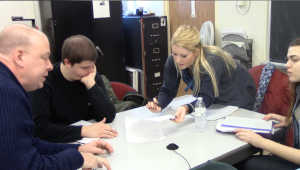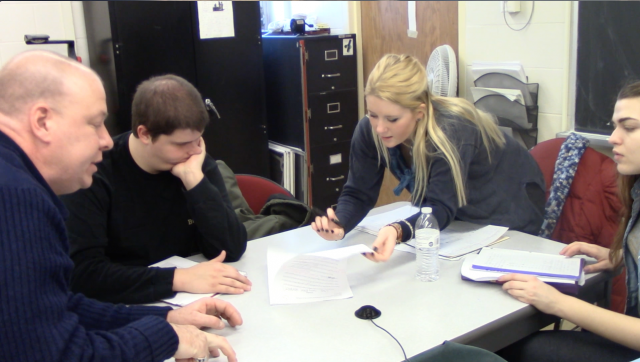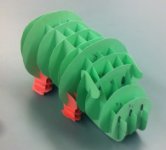DAoM and Math Majors
Written by: Dr. Julian Fleron.
The primary audience of Discovering the Art of Mathematics is mathematics for liberal arts students.
The scope of the project’s work continues to expand to include audiences that are more and more diverse. Here we describe the project’s connection to Mathematics majors.
What we have found is that Discovering the Art of Mathematics has great value in recruiting mathematics majors AND our view of our Mathematics major has been deeply informed by our work on this project.
Recruitment of Mathematics Majors
The recruitment is best described by sharing my new favorite story that I used to energize my mathematics for liberal arts students on the first day of the current semester. I told them…
"At that table right over there, exactly four years ago today (plus or minus a few days) a first-year, undeclared student walked into this course.
As a kid she kept mathematics flashcards in her purse and `would study them any chance she could.’ But later she became used to mathematics that was `dull and repetitive.’ In this course, in this classroom, this world of mathematics `was quickly replaced by the exciting, and challenging mathematics I study today.’
She declared mathematics as her major before the end of the semester, going on to discover that mathematics is `her true passion.’ Her passion. Got that?
This past May she walked across the graduation stage as the Department of Mathematics Academic Excellence Award-winner. She did a wonderful, year-long Research Experiences for Undergraduates program on mathematics and music. Original research. She was a great candidate for graduate school but decided that teaching was her calling. She’s in the classroom now. And let me tell you, she will be a great teacher.
That distinguished academic career started right here. In this room. In this course."
[For more, see Rachel’s full story .]
And then I told them another story…
"At that table right over there, exactly three years ago today (plus or minus a few days), a first-year, undeclared student walked into this course. He `wasn’t very happy’ to be in the class and `thought it would honestly be a waste’ of his time. Instead, he discovered that mathematics can `be so interesting and so beautiful.’ This class was his favorite class his first semester and he declared mathematics as his major before the end of the semester.
Guess what? He now freely shares that he `loves’ mathematics. And he has been amazingly successful.
Today he enters the academic year as a rising senior with the second highest GPA in his class. He is working on an amazing Senior Honors Project/Research Experiences for Undergraduates that will likely result in a peer-reviewed, published paper and his algorithm for intercardinal landscapes metrics will almost certainly be introduced into all of the major GIS systems in the world – helping landscape ecologists measure erosion. He’s a strong candidate for jobs in GIS but is also a strong candidate for graduate programs in Mathematics or Geography. He’s got lots of wonderful options."
[For more, see Nic’s full story.]
And then I asked them if they saw a pattern. And I told another story…
"We missed out on this year’s cohort of juniors. But, a year ago today (plus or minus a few days), a first-year, undeclared student walked into this class. She already successfully learned `Algebra, Geometry, and Calculus’ but figured there wasn’t much else to mathematics - `what else is there really?’ In this course she discovered `there is really not a limit to math’ and the course pushed her `into thinking about how I could help kids in high school learn and appreciate math.’ She declared Mathematics as a major, with a concentration in Secondary Education. Today she enters the academic years as a rising sophomore with the second highest GPA in her class."
[For more, see Nickey’s full story.]
I told these stories in part because of my pride in the development and accomplishments of these three students. I hoped it would elicit some response from the students. What I got was much more than I expected. They asked lots of questions, "Where’s the one who graduated teach?" "Will he get paid for the GIS thing?" "It’s great that two of them want to be a teachers, we need good mathematics teachers." But they also asked questions about the implications for their experience: "Are we really going to get to do real mathematics like they did?" "Do I really have a shot at being a mathematics major?"
Normally I use the lure of no tests, a free textbook and no lecturing to hold them long enough for their immersion in inquiry to kick in. Then they are hooked by nature of actually doing mathematics – something that is largely new to them. But after these stories I didn’t need to my usual enticements to get things going – these stories were enough. They wanted their opportunity to see the unexpected in mathematics. They wanted the opportunity to do mathematics as mathematicians do. They were ready to see what their story would be.
Finding Great Students
We share the story of these three students not because we think mathematics for liberal arts courses that use DAoM will double the size of Mathematics major programs. As a feeder for the major, we only get one or two new Mathematics majors a year. While this is nontrivial when you have an incoming cohort of majors whose average size is 20, there is a much bigger lesson.
In three out of four of the last years in a row, in a department that graduates about 20 majors a year, one of our top two students in each class came in undeclared and discovered the art of mathematics in a DAoM course for non-majors. This is remarkable. And we think this gives us license to wonder aloud…
If eleventh and twelfth graders used DAoM might the number of students who considered majors in Mathematics in college grow substantially? If the typical fare of algebra, geometry and precalculus gave up some of its prominence to content and pedagogy like DAoM might this actually significantly increase the number of energized, interested students who move towards Mathematics and mathematically intensive fields?
Getting Mathematics Majors to Discover the Art of Mathematics
There’s a reverse moral to this story as well. Namely, that the topics in Discovering the Art of Mathematics are so rich that there is a wealth of things that would be beneficial to our mathematics majors. Our group often laments that we get to teach an entire course on the infinite to our mathematics for liberal arts students but our majors rarely have the opportunity to study the infinite as a significant part of their major program. We teach knot theory to liberal arts students more often than topology to majors.
We do projective geometry and panoramic photography with our liberal arts students, how do we squeeze this into our geometry for majors course? Our majors see groups and transformations, but how much of a chance do they get to see them applied to dance, music, and art? Where do we put the game theory in our major? Where do our majors learn about the limitations of knowledge like Gödel’s theorem?
The inquiry-based approach of DAoM informs our major courses significantly. But it is a shame that our majors don’t get to also work through the content that makes up the DAoM library. They would be much richer mathematicians for it.
DAoM Materials Used in Typical Major Courses
Fortunately, we have increasingly found valuable ways to include topics and materials from DAoM in our courses for majors. A sampling of these opportunities include:
- String art plays prominently in motivating our teaching of tangent lines in Calculus I. While we do not make string art, we use many of the activities and string art pieces in our course. (DAoM – Calculus)
- Similarly, stock sliceforms and the Flatland game are used in Calculus III. (DAoM – Geometry)
- "Panoramic Photography" (DAoM – Art & Sculpture) is often used as an important unit on spherical geometry in our Geometry for majors course.
- Beefed up versions of many of the chapters in DAoM – Number Theory often occupy a large role in our Number Theory course for majors.
- Symmetry groups in dance (DAoM – Dance) and of the flexagon (DAoM – Art & Sculpture) can be used to introduce and motivate groups in Abstract Algebra.
- Beefed up versions of many of the chapters in DAoM – Knot Theory have been used in our Topology course.
- Activities involving explorations of the infinite (DAoM – Infinity) are often used as beginning activities in our Real Analysis course.
DAoM Materials as an Introduction to the Mathematics Major
Additionally, DAoM materials have come to occupy a central role in our course “Introduction to Mathematical Systems.’’ For first year majors, this course is designed as a bridge to a more rigorous and sophisticated proof/logic course that students take as sophomores. The latter course prepares majors for the upper level courses while this former course focuses on problem solving, patterns, proof and an introduction to mathematical culture.
Fundamental topics for this course include materials from:
- "Introduction – Mathematics as the Art and Science of Patterns" (DAoM – Patterns, Chapter 1)
- "Patterns and Proof" (DAoM – Patterns, Chapter 2)
- "Pascal’s Triangle" (DAoM – Patterns, Chapter 8 [forthcoming])
- "Establishing Truth – Certainty and Burdens of Proof" (DAoM – Truth, Reasoning, Certainty & Proof, Chapter 3)
- "Types of Reasoning" (DAoM – Truth, Reasoning, Certainty & Proof, Chapter 4)
- "Proof" (DAoM – Truth, Reasoning, Certainty & Proof, Chapter 5)
- "Limits of Knowledge – Proving Impossibility" (DAoM – Truth, Reasoning, Certainty & Proof, Chapter 6)
- "20th Century Revolutions in Thought" (DAoM – Truth, Reasoning, Certainty & Proof, Chapter 7)
Additional topics for this course may also be included. This semester I am using number theory to illustrate contemporary advances in mathematics, including
- Fermat’s last theorem (using "The World’s Greatest Mathematical Problem," Chapter 7 of DAoM – Number Theory)
- The Green/Tao theorem and Zhang’s result on bounded gaps between primes (from sections of "Primes and Congruences," Chapter 3 of DAoM – Number Theory)
- The Riemann hypothesis and Birch and Swinnerton-Dyer conjecture (from "Class Numbers: A Bridge Between Two $1 Million Dollar Problems," Chapter 4 of DAoM – Number Theory)
We developed the Discovering the Art of Mathematics library so the deep connections of mathematics to art, history, culture, humanism, philosophy, and literature could be fully incorporated into the mathematical experiences of MLA students for whom they are so very relevant. These connections are important to our majors as well. We invite you to explore ways in which our materials can enrich your major students’ views of the roles of mathematics in these areas.











